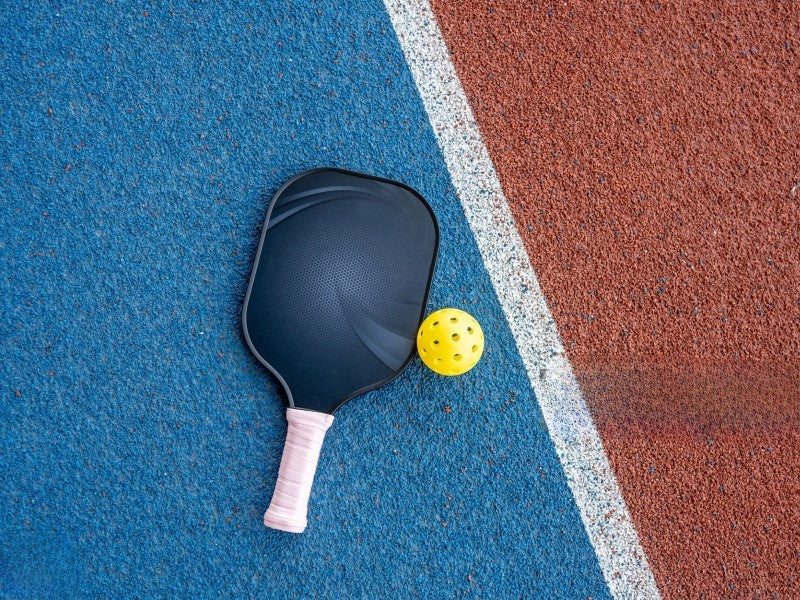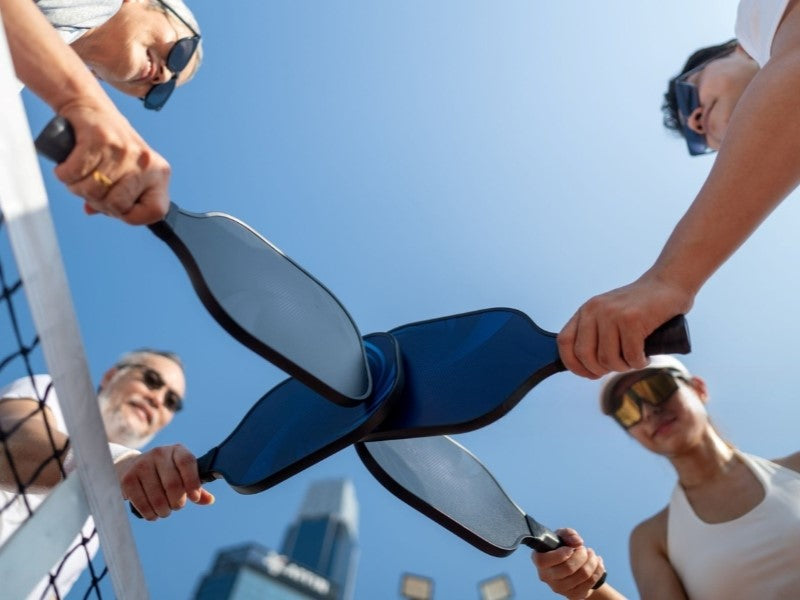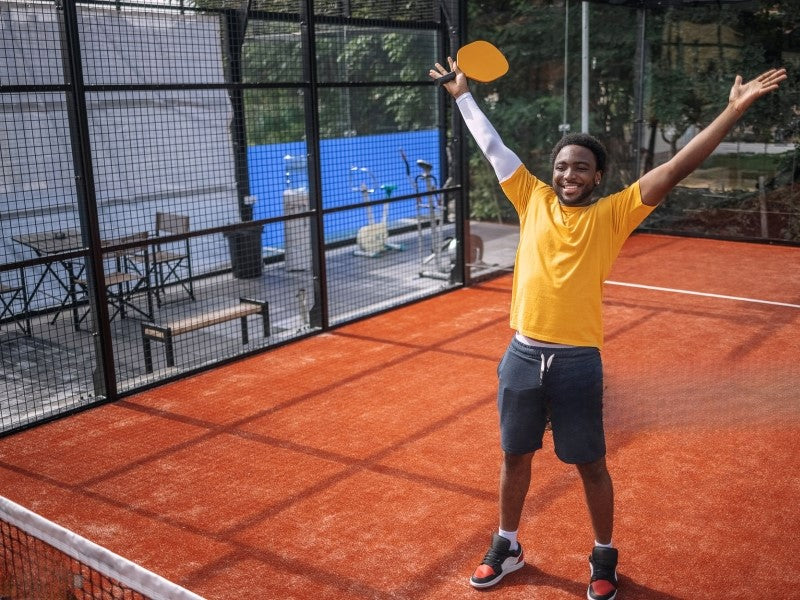For beginners, the paddle isn’t just a tool—it’s a gateway to learning proper technique, avoiding injury, and enjoying the game from day one. The right paddle should feel like a natural extension of your arm—comfortable, balanced, and tailored to your learning style.
This comprehensive beginner’s guide will help you identify the best pickleball paddle for beginners, explain all key features, and walk you through real paddle recommendations. Whether you want to improve faster, avoid arm fatigue, or simply have more fun, this guide has everything you need to make an informed choice.
Pickleball Paddle Basics: Key Terms and Features Explained
Before you start comparing paddles, it’s crucial to understand the terms manufacturers and retailers use. Every component of a paddle influences its feel in your hand and its performance during gameplay.

a. Paddle Weight
Weight ranks among the most crucial factors for new players. It directly affects control, swing speed, and comfort.
- Lightweight (6.9–7.4 oz): Easier to maneuver and control; great for wrist and elbow comfort.
- Midweight (7.5–8.4 oz): Offers a balance of power and control; ideal for most beginners.
- Heavyweight (8.5 oz and up): More power but less control and more arm fatigue.
Beginner Tip: Start with a midweight paddle unless you have joint issues—then consider lightweight options.
b. Core Material
A paddle’s core shapes the sensation of the ball making contact with the paddle’s surface.
- Polymer Core (PP): The most popular and quietest. Offers great control and a softer feel.
- Nomex Core: Stiffer and noisier, providing greater power but offering less forgiveness.
- Aluminum Core: Lightweight with moderate touch and power but less durability.
Beginner Tip: Stick with a polymer core for better control and comfort.
c. Paddle Surface Material
The face material affects spin, touch, and durability.
- Composite: Offers a gritty surface for spin and excellent all-around performance.
- Graphite: Lightweight with excellent touch and control; slightly more expensive.
- Wood: Affordable but heavy and outdated; not ideal for beginners looking to improve.
Beginner Tip: Choose composite or graphite paddles for better performance.
d. Paddle Shape
Paddles come in several shapes, each affecting sweet spot and reach.
- Standard/Classic: Balanced, with a wider sweet spot.
- Widebody: Great for beginners due to a larger surface area.
- Elongated: Offers more reach but a smaller sweet spot and less forgiveness.
Beginner Tip: Go with a widebody paddle if you're new and want consistency.
e. Grip Size and Handle Length
Grip comfort is critical. A grip that’s excessively large or small may cause discomfort or even injury.
- Grip Size: Ranges from 4" to 4.5". Smaller hands should choose smaller grips.
- Handle Length: Shorter handles allow more control; longer handles help two-handed backhands.
Beginner Tip: Use this test—if your fingers overlap or barely touch, it’s the right grip size.
f. Edge Guard or Edgeless Design
- Edge Guard: Adds protection but may interfere with shots near the paddle’s edge.
- Edgeless design: Streamlined, with a larger striking area but more prone to damage.
Beginner Tip: An edge guard is better for beginners as it protects against accidental drops.
Common Mistakes Beginners Make When Choosing a Paddle
Many first-time players make poor paddle choices due to flashy marketing or bad advice. Avoid these pitfalls:
a. Buying Based on Price Alone
Cheapest paddles often sacrifice balance, comfort, and durability. Expensive ones may include features you don’t need yet.
Better Approach: Set a budget around $50–$100 and focus on fit and function.
b. Choosing a Pro-Level Paddle
You may see pros using elongated graphite paddles—but these are often too advanced for beginners.
Better Approach: Start with a beginner-friendly paddle with a wide sweet spot.
c. Ignoring Grip and Weight
The wrong grip can cause wrist fatigue. A paddle that’s too heavy can hurt your elbow.
Better Approach: Pick a grip size that matches your hand and stay within a comfortable weight range.
d. Overlooking Indoor vs Outdoor Use
Some paddles are optimized for outdoor play (with heavier balls), while others are better for indoor courts.
Better Approach: Choose a versatile paddle unless you know your playing environment.
Paddle Types and Materials: What’s Best for Starters?
Let’s explore the types of materials and construction styles available, focusing on what’s best for new players.
a. Graphite Paddles
· Pros: Lightweight, responsive, consistent ball contact.
· Cons: Slightly more expensive.
· Best for: Players who want control and finesse.
b. Composite Paddles
· Pros: Durable, textured for spin, good control and power balance.
· Cons: Slightly heavier.
· Best for: All-around beginners who want versatility.
c. Wood Paddles
· Pros: Cheapest option.
· Cons: Heavy, low performance, not forgiving.
· Best for: Schools or rentals—not serious beginner players.
d. Polymer Core
· Pros: Quiet, soft feel, control-oriented.
· Cons: Slightly less power than harder cores.
· Best for: First-time players.
e. Nomex or Aluminum Cores
· Pros: Power-focused, responsive.
· Cons: Loud and hard, less forgiving on mis-hits.
· Best for: Intermediate or aggressive players—not ideal for new learners.
How to Choose Based on Your Playing Style (Even if You’re Just Starting)
While most beginners haven’t developed a defined playing style, your physical condition and preferences can still guide your choice.
a. Control-Oriented Players
If shot accuracy, extended rallies, and skillful technique matter to you, opt for:
· Lightweight paddle (7.3–7.8 oz)
· Polymer core
· Graphite face
· Smaller grip
Best Match: Beginner women, senior players, or tennis converts
b. Power-Oriented Beginners
Want to smash and play more aggressively?
· Midweight or slightly heavy paddle (7.9–8.4 oz)
· Nomex or aluminum core
· Composite face
· Standard or larger grip
Best Match: Younger players, those with athletic backgrounds
c. Players with Joint Sensitivity
If you have elbow, wrist, or shoulder issues:
· Lightweight paddle
· Polymer core
· Comfortable, tacky grip
· Shock-absorbing handle design
Best Match: Older beginners or those recovering from injuries
d. Indoor vs Outdoor Consideration
· Outdoor paddles are generally heavier and textured to handle wind and harder balls.
· Indoor paddles can be lighter and offer more touch.
Beginner Tip: Opt for a multi-purpose paddle unless you’re dedicated to a specific playing setting.

Top 6 Pickleball Paddles for Beginners (with Comparison Table)
With hundreds of options on the market, narrowing it down can be tough. Based on beginner-specific needs—like comfort, forgiveness, and affordability—we’ve selected five of the best beginner paddles that deliver great value and on-court performance.
Comparison Table: Best Beginner Paddles
|
Brand/Model |
Weight (oz) |
Core Type |
Face Material |
Grip Size |
Price Range |
Best For |
|
Selkirk Latitude Widebody |
6.9–7.4 |
Polymer |
Composite |
4.25" |
$50–$70 |
Control and comfort |
|
Onix Z5 Graphite |
7.5–8.2 |
Nomex |
Graphite |
4.25" |
$60–$90 |
Power with balance |
|
HEAD Radical Elite |
8.1 |
Polymer |
Composite |
4.25" |
$40–$60 |
All-around starter performance |
|
Gamma Fusion LE |
8.0 |
Aramid |
Fiberglass |
4.125" |
$45–$65 |
Budget-friendly with good touch |
|
Niupipo MX-06 Set |
7.8 |
Polymer |
Graphite |
4.25" |
$50 (2 paddles) |
Families or casual rec players |
|
7.5–7.8 |
Polymer / T700 Carbon |
Raw carbon fiber |
4.25″ |
$80–$100 |
Beginner-friendly, spin control, pro grade |
Budget Considerations: How Much Should You Spend?
Purchasing a paddle doesn’t have to cost a fortune. Here’s what to expect at different price levels:
Under $50
· Basic beginner models
· Likely heavier or less durable
· Often sold in multi-packs or bundles
Best for: Kids, families, budget-conscious players
$50–$100
· Mid-range paddles from trusted brands
· Good materials, balanced features
· Suitable for growth as a beginner improves
Best for: Most serious beginners
$100+
· Premium paddles with high-performance cores
· Lighter, optimized for control/spin
· Often used by intermediate or advanced players
Best for: Players ready to invest in long-term performance
Where to Buy: Online vs Local Stores vs Pro Shops
a. Online Retailers (Amazon, Pickleball Central, Brand Sites)
· Broadest selection and frequent discounts
· Easy comparison
· Be cautious of counterfeits or third-party sellers
Tip: Look for USAPA approval and seller reviews.
b. Sporting Goods Stores (Dick’s, REI, Decathlon)
· Try paddles in hand
· Easier returns or exchanges
· Staff may not be pickleball experts
Useful if you prefer to experience grip size and weight in person.
c. Local Clubs and Pro Shops
· May offer demo days or test drives
· Personalized advice
· Usually smaller selection
Best for high-quality advice and getting matched with a coach or group.
Final Tips for New Players Buying Their First Paddle
1. Comfort matters more than power.
If your arm hurts or grip feels awkward, you'll never enjoy playing.
2. Don’t be swayed by brand hype.
Top brands like Selkirk, Engage, or Paddletek have great options, but many off-brand paddles also deliver.
3. Test before you commit.
If possible, borrow or demo a few paddles to understand what feels best in your hand.
4. Grip tape can solve a lot.
If a grip is too small or slippery, inexpensive grip wraps can fix it.
5. Remember your paddle is a learning partner.
You’ll grow into your game—but your paddle should support that growth, not hold it back.
Selecting the ideal pickleball paddle for new players is the first major step in your pickleball adventure. It’s not about choosing the most expensive or most advanced paddle—it’s about finding one that fits your hand, matches your comfort level, and helps you develop your skills with confidence.
From weight and grip to surface and core, each element plays a role in shaping your playing experience. By understanding the fundamentals and comparing real options, you can invest in a paddle that grows with you—not against you.









Leave a comment
This site is protected by hCaptcha and the hCaptcha Privacy Policy and Terms of Service apply.